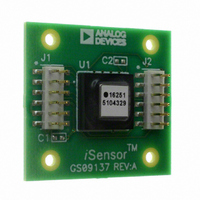ADIS16251/PCBZ Analog Devices Inc, ADIS16251/PCBZ Datasheet - Page 15

ADIS16251/PCBZ
Manufacturer Part Number
ADIS16251/PCBZ
Description
BOARD EVALUATION FOR ADIS16251
Manufacturer
Analog Devices Inc
Series
iMEMS®, iSensor™r
Specifications of ADIS16251/PCBZ
Sensor Type
Gyroscope, 1 Axis
Sensing Range
±20°/sec, ±40°/sec, ±80°/sec
Interface
SPI Serial
Sensitivity
0.004°/sec/LSB
Voltage - Supply
4.75 V ~ 5.25 V
Embedded
No
Utilized Ic / Part
ADIS16251
Silicon Manufacturer
Analog Devices
Application Sub Type
Angular Rate Sensor / Gyroscope
Kit Application Type
Sensing - Motion / Vibration / Shock
Silicon Core Number
ADIS16251
Kit Contents
Board
Lead Free Status / RoHS Status
Lead free / RoHS Compliant
For Use With
ADISUSBZ - KIT EVAL ADIS W/SOFTWARE USBADISEVALZ - KIT PC EVALUATION W/SOFTWARE
Lead Free Status / RoHS Status
Lead free / RoHS Compliant
OPERATIONAL CONTROL
Internal Sample Rate
The internal sample rate defines how often data output variables
are updated, independent of the rate at which they are read out
on the SPI port. The SMPL_PRD register controls the ADIS16251s
internal sample rate and has two parts: a selectable time base
and a multiplier. The sample period can be calculated using
the following equation:
where:
T
T
N
The default value is the maximum 256 SPS, and the contents of
this register are nonvolatile.
Table 14. SMPL_PRD Register Definition
Address
0x37, 0x36
Table 15. SMPL_PRD Bit Descriptions
Bit
15:8
7
6:0
The following is an example calculation of the sample period for
the ADIS16251:
The sample rate setting has a direct impact on the SPI data rate
capability. For sample rates of 64 SPS and above, the SPI SCLK
can run at a rate up to 2.5 MHz. For sample rates below 64 SPS,
the SPI SCLK can run at a rate up to 1 MHz.
The sample rate setting also affects the power dissipation. When
the sample rate is set below 64 SPS, the power dissipation reduces
by a factor of 60%. The two different modes of operation offer a
system-level trade-off between performance (sample rate, serial
transfer rate) and power dissipation.
S
B
S
is the sample period.
is the time base.
is the increment setting.
T
If SMPL_PRD = 0x0007, B7…B0 = 00000111
B7 = 0 → T
B6…B0 = 000000111 → N
T
f
S
S
S
= 1∕T
Description
Not used
Time base, 0 = 1.953 ms, 1 = 60.54 ms
Multiplier
= T
= T
B
B
S
× (N
× (N
= 64 SPS
B
Default
0x0001
= 1.953 ms
S
S
+ 1)
+ 1) = 1.953 ms × (7 + 1) = 15.624 ms
S
= 7
Format
N/A
Access
R/W
Rev. A | Page 15 of 15
Power Management
In addition to offering two different performance modes for
power optimization, the ADIS16251 offers a programmable
shutdown period. Writing the appropriate sleep time to the
SLP_CNT register shuts the device down for the specified
time. The following example provides an illustration of this
relationship:
After completing the sleep period, the ADIS16251 returns to
normal operation. If the measurements are required before the
sleep period completion, the ADIS16251 can be awakened by
putting the CS line in a zero logic state. Otherwise, the CS line
must be kept high to maintain sleep mode.
Table 16. SLP_CNT Register Definition
Address
0x3B, 0x3A
1
Table 17. SLP_CNT Bit Descriptions
Bit
15:8
7:0
Analog Bandwidth
The analog bandwidth of the ADIS16251 is 49 Hz. This band-
width can be reduced by placing an external capacitor across
the RATE and FILT pins. In this case, the analog bandwidth
can be calculated using the following equation:
where:
R
C
Digital Filtering
The ADIS16251 GYRO_OUT signal path has a nominal analog
bandwidth of 49 Hz. The ADIS16251 provides a Bartlett Window
FIR filter for additional noise reduction on all of the output data
registers. The SENS/AVG register stores the number of taps in
this filter in seven power-of-two, step sizes (that is, 2
16, 32, 64, and 128). Filter setup requires one simple step: write
the appropriate M factor to the assigned bits in the SENS/AVG
register. The bit assignments are listed in Table 19. The fol-
lowing equation offers a frequency response relationship for
this filter:
Scale is the weight of each LSB.
OUT
OUT
B7 … B0 = 00000110
Sleep period = 3 sec
f
= 180 kΩ.
= external capacitance.
H
OUT
B
(
= 1/(2π × R
f
)
=
Description
Not used
Data bits
Scale
0.5 sec
H
A
2
(
1
f
OUT
)
⇒
Default
0x0000
× (C
H
A
OUT
(
f
+ 0.018 μF))
)
=
Format
Binary
sin(
N
×
π
sin(
×
N
π
×
×
Access
R/W
ADIS16251
f
f
×
×
M
t
t
= 1, 2, 4,
S
S
)
)












